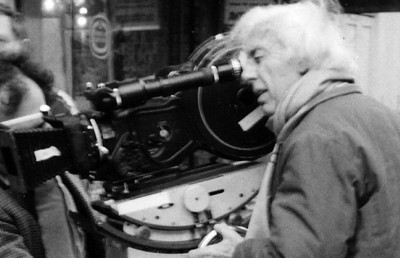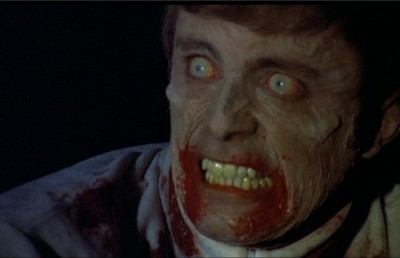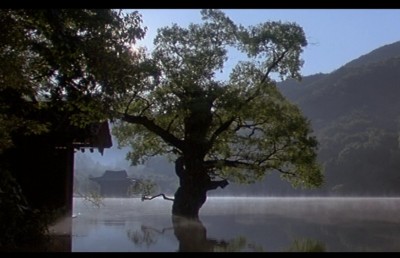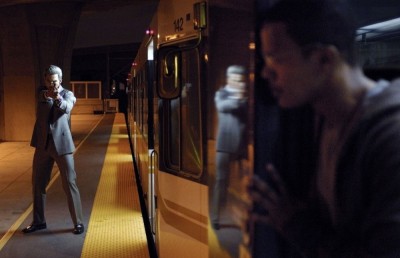Fassbinder: The Life and Work of a Provocative Genius
Book by Christian Braad Thomsen
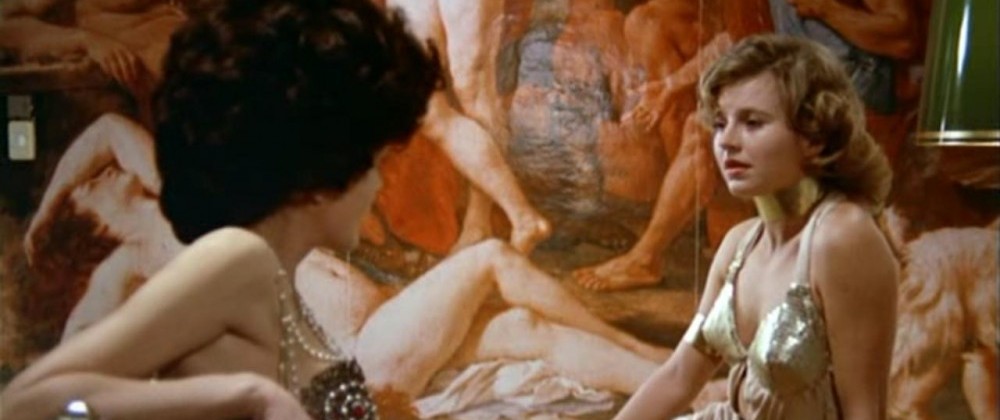
Rainer Werner Fassbinder died in 1982 at the age of 37, shortly after having completed his final film Querelle, adapted from Jean Genet’s Querelle de Brest. Upon completing Christian Braad Thomsen’s book, the reader will wonder at which point Fassbinder, who divided his time between the cinema and theatre as director, screenwriter, producer, and actor, lived but for his art. Seen this way, Fassbinder’s career becomes one long passion, in the religious sense of the term. The insatiable need to create appears like a pathology of exuberant creation and suffering, which he inflicted not only on himself but on his many collaborators, which accounts for the theme of masochism which recurs throughout all his work. What Fassbinder accomplished in such a relatively short time is simply stupendous, and it is highly unlikely for a contemporary artist to aspire to be as prolific. As Thomsen remarks:
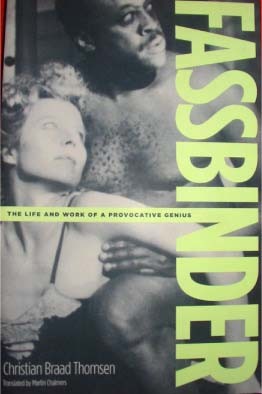
The speed at which Fassbinder worked and his workaholism must be unique in film history. Directors usually manage, at most, a feature film every two years; Fassbinder rarely made less than four films a year, always based on his original ideas. Only rarely did he enlist the help of others for a script. He made 33 feature films for cinema and TV, fourtelevision series (consisting of a total of 23 episodes) and four feature-length video films, which makes a total of 60 individual units for film and television within the space of thirteen years. On top of that, Fassbinder wrote or directed 30 plays for the stage and four for the Radio. As an actor, he appeared in a large number of his own films, as well as in 12 films by other directors, four times in the lead role. From the start, he was his own producer and only when his films were more successful commercially was he able to hire other producers. He also produced three films for other directors. He edited several of his own films, and was his own cameraman twice. 1
With such a career it is not surprising that Fassbinder died at a young age and that in the final months of his life his physical appearance made him look much older than he really was.
We already know certain details of Fassbinder’s life (an abandoned childhood, his homosexuality, his lovers, his paper marriage with singer/actress Ingrid Caven) and his work habits (the painful love-hate relationships he maintained with his actors and actresses), but one thing is clear: the life in question in Thomsen’s book is of a man totally devoted to cinema and theatre. Thomsen, who was a friend of Fassbinder’s, is to be applauded for presenting an exhaustive study which incorporates autobiography and the principal themes present in all of Fassbinder’s work.
Although all of Fassbinder’s films are discussed, the universe of the theatre is also of central importance, since it was through theatre that Fassbinder learned how to make cinema: “In the theatre I always directed as if it were a film, and then shot the films as if it were theatre, I did that fairly determinedly.” [Ibid, p. 48.]] This particular formal quality of many Fassbinder films contributes to the provocative dimension which the book’s title alludes to. Also, to varying degrees, all his early features, such as Love is Colder than Death (1969), Katzelmacher (1969), The Journey to Niklashausen (1970) and Pioneers in Ingolstadt (1970), show traces of Action Theatre and Antitheatre, companies which, at that time, were fleetingly linked to Fassbinder’s name. These films were marked by anecdotal action, the use of static long takes, the absence of montage, and the stylized gesturing of the performers. These early films, in which we can strongly sense the influence of Jean-Luc Godard, Jean-Marie Straub and Glauber Rocha, demonstrate a modernist approach where the sense of spectacle is purposely stripped away to prevent spectator identification with characters or their situations. At this early point Fassbinder’s cinema also begins to manifest a strong duality, one made in the image of Fassbinder’s own double nature in which the multiple excesses remain symptomatic of a personality replete with paradoxes. At this point Fassbinder also begins to conceive within the same film the coexistence of certain clichés derived strictly from genre cinema with a cinematographic language approaching minimalism. On the basis of social satire, Whity (1970) becomes a spaghetti-western pastiche and The American Soldier (1970) becomes an hommage to the Hollywood gangster film; however, Fassbinder renounces the temptation to purely entertain his audience.
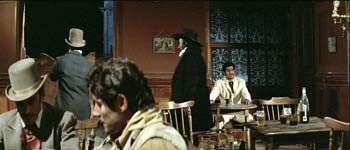
Whity
With The Merchant of Four Seasons (1971), Fassbinder begins to appropriate the conventions of the Hollywood melodrama, which is where his admiration for Douglas Sirk begins to flower. In The Bitter Tears of Petra von Kant (1972), Fassbinder problematises character identification through his critical attitude toward them and the extreme stylisation of the film. By contrast Ali: Fear Eats the Soul (1973), adapted from Sirk’s All that Heaven Allows (1955), and Fox and his Friends (1974), present warm and endearing central characters with which spectators can easily identify with and respond to emotionally.
However, true to his reputation as a provocateur, Fassbinder does not continue along this path but instead finds the means to confound his audience with his subsequent films, each more disconcerting than the other: Satan’s Brew (1975), for which Fassbinder had but the following words to say: “Just take a look at what a completely unbearable film I can make – now hit me” 2 and Chinese Roulette (1976) which, notwithstanding the remarkable cinematography by Michael Ballhaus, “is a mystification, close to narrative laziness”. Ibid, p. 220.]] Fassbinder would continue to be unpredictable after the international success of The Marriage of Maria Braun (1978), at which point he would stop working with Ballhaus and become his own cinematographer on two extremely personal and demanding films: In a Year with Thirteen Moons (1978) and The Third Generation (1978-9).
This “doppelgänger” aspect of Fassbinder’s personality is a central motif of his work and Thomsen brings it out in many films, notably across the use of mirrors which, as well as creating interesting effects in mise en scene and false perspective, becomes the ideal metaphor to represent the double nature of personality and the illusions which separate reality from appearance. Fassbinder makes the most consistent and sophisticated use of this in Effi Briest (1972-4):
No one-sided interpretation of the many mirror-images is intended here, since their function is often rather nuanced. They not only serve to expose the ambiguity of a situation, but also to frame the characters in the manner of stiff family portraits, and to demonstrate that the characters are tied to a family tradition from which they cannot free themselves. At several points one wonders for a moment whether one is looking at a living mirror-image or at a lifeless photograph on the wall. These characters often stand like lifeless portraits in their own lifes – bound to a gender model in which the development of the lives of individuals freezes into a gesture determined by tradition. 3
The reading of Querelle (1982) is also founded in large part on the theme of the double. In this final film, which many people have considered –perhaps wrongly- to be Fassbinder’s personal testament, sex and death are synonymous, constantly echoing each other and becoming interchangeable values.
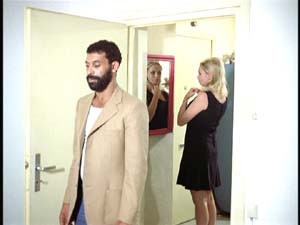
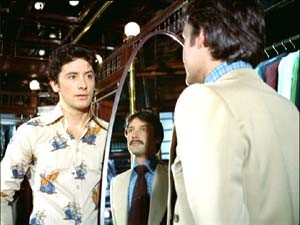
Use of the mirror in Ali: Fear Eats the Soul (above) and Fox and his Friends
A life-long provocateur, Rainer Werner Fassbinder never ceased probing fundamental aspects of German society. Thomsen demonstrates with acuity how this critical attitude gave great sustenance to the controversy surrounding Fassbinder which, in his lifetime, saw perhaps more detractors than admirers. This may go a long way in explaining the presence of characters mired in relationships of domination and masochism in many of Fassbinder’s films. The feminists fiercely attacked The Bitter Tears of Petra von Kant on the pretext that the relations between the women operated strictly at the level of emotional dependence and victimisation. Likewise the homosexual community did not respond well to the sordid and pessimistic vision Fassbinder presented between two men of different social class in Fox and his Friends. And the militant left was far from ecstatic about the unflattering depiction of the left in Mother Küster’s Trip to Heaven (1975). Personally, Fassbinder reached an important crisis point when he was outrageously accused of anti-Semitism with regards to his theatre piece Garbage, the City and Death which, to this day, has not been presented in Germany, even though it was written in 1975.
To better illustrate the theme of domination which exists in Fassbinder’s works, Thomson analyses the iconographic motif of dolls and mannequins present in many of his films, which function as an accessory of the mise en scene and an extension of the double motif:
Fassbinder often comments on the situation of a film character by doubling the character with a plaster figure or a statue. Sometimes, the dummies also function as projection surfaces for parts of the psyche,of dreams and longings, or they show how we treat one another: not as human beings with a soul and reason, but as commodities. The mannequins in The Bitter Tears of Petra von Kant are often arranged so as to say something about Petra’s relationship to her surroundings; Petra’s girlfriend gives her a doll, which is supposed to replace the lost lover, while her maid’s make-up turns her into a living doll, and she is treated as such. 4
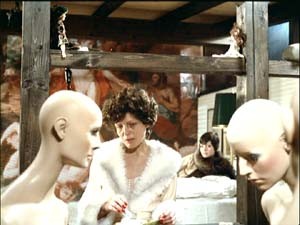
The Bitter Tears of Petra von Kant
Along with the considerable space dedicated to Fassbinder’s theatre experiences, another strong point of Christian Braad Thomsen’s book is the detailed analysis of the three series Fassbinder produced for German television. Although it is fairly easy to view the 13 parts and epilogue of Berlin Alexanderplatz (1979-80) on home video, it is a good bet that the other two TV series will never get similar distribution in North America: Eight Hours Are Not a Day and World on a Wire, televised respectively in 1972 and 1973. These two shows, which according to Thomsen attained considerable success in Germany, present a lesser known aspect of Fassbinder’s work which many viewers would no doubt want to discover. Eight Hours Are Not a Day is a family saga told in five episodes which shows that Fassbinder had the capacity, when he wanted, to reach a mass public while treating themes that were dear to him, but with a tone far more light and optimistic than that found in the majority of his films. The series World on a Wire, filmed in two episodes, is an adaptation of the novel by writer Daniel F. Galouye. The action of both the novel and film takes place in a future civilization where humans live conjointly with robots created in their image, a science-fiction canvas which recalls Ridley Scott’s Blade Runner, made nearly ten years later.
The superlative “provocative genius” affixed to the title of Thomsen’s book may lead one to think that the author does nothing but flatter all of Fassbinder’s works. Fortunately, Thomsen restrains himself from such excessive flattery. One must certainly have a committed passion with said subject to engage such a large body of work in great detail, but Thomsen also possess the critical distance necessary to reveal the weaknesses of certain films, even considering some of them as total missteps. Acccording to Thomsen, Rio das Mortes (1970) and Lili Marleen (1980), directed without much conviction, constitute two weak links in Fassbinder’s career. By contrast, the ambitious Chinese Roulette, Despair (1977) and Querelle remain fascinating, although problematic on a narrative level.
Notwithstanding the book’s great qualities there are nonetheless certain gaps, although they do not detract from the pleasures gained from reading the book. One would have hoped for a more detailed formal analysis where certain films were concerned. Thomsen traces the aesthetic traits common across Fassbinder’s work in general terms. Even though the symbolism of the mise en scene is treated with considerable conviction, elements such as camera movement and the role of sound, notably music, are rarely discussed. This is especially pertinent because Fassbinder often worked with the same technical crew. To this end, cinematographer Michael Ballhaus conceived, notably for Whity, Martha (1973) and Chinese Roulette, camera movements of extreme sophistication which bear little significance in Thomsen’s analysis. And what of the role of Peer Raben’s music in a body of work often inspired by the codes of the Hollywood melodrama?
Additionally, one may be annoyed by certain Freudian interpretations which Thomsen resorts to throughout his analysis. One can not deny that certain events in Fassbinder’s life –his relationship with his mother, his homosexuality, and his penchant for masochism– can justify a psychoanalytical reading of his oeuvre, Querelle in particular. Fassbinder even had the idea of adapting to cinema Freud’s Moses and Monotheism. However, Thomsen sometimes attributes excessive Freudian symbolism to certain scenes or objects, notably with respect to the subject of Martha:
In the Freudian interpretation of dreams, steps are a symbol for intercourses. When Martha climbs the steps with her father, that expresses her repressed erotic desire for the one who had already rejected her when she was a small child. Then her need was legitimate and natural, but because of the stern rejection it encountered, it has survived into adult life in repressed form. The bag is a vagina symbol and the fact that it is stolen at the very moment her father dies signals that Martha’s sexuality is now being stolen or confiscated for ever. 5
Certainly Freudian interpretations can bring an additional satisfaction to the appreciation of Fassbinder’s films, but they do not constitute an essential prerequisite to their comprehension, as Thomsen indicates.
Fassbinder talked about his relationship to cinema in the following terms: “I would like to build a house with my films. Some are the cellar, others the walls and others again are the windows. But I hope that, in the end, it will be a house”. 6 Christian Braad Thomsen’s book marks an immense contribution to the knowledge and comprehension of a large body of work whose director compared to the architecture of a house. Without doubt, The Life and Work of a Provocative Genius constitutes an indispensable complement to the many Fassbinder films which have been recently released on DVD.
Translated from French by Donato Totaro
Notes
- Christian Braad Thomsen, Fassbinder: The Life and Work of a Provocative Genius, Minneapolis: University of Minnesota Press, 2004, p. 8. ↩
- Ibid, p. 212. ↩
- Ibid, p. 150. ↩
- Ibid, p. 28. ↩
- Ibid, p. 157. ↩
- Ibid, p. 8. ↩


